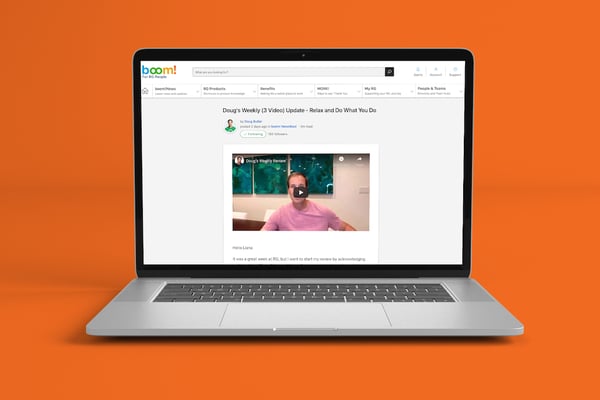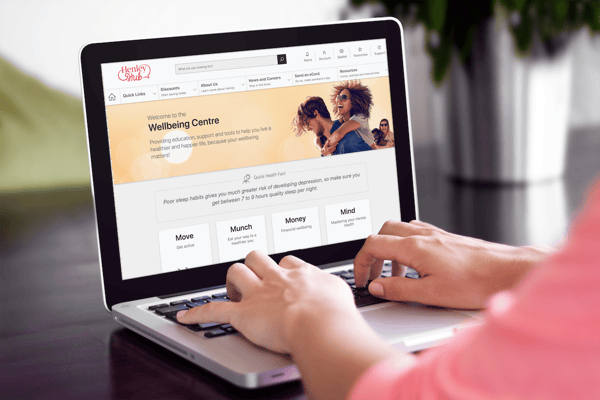Evolving your employee engagement strategy to motivate and inspire your people wherever they’re working
COVID-19, like most of us, isn’t going anywhere any time soon. Even if the global pandemic magically disappeared overnight, there’s no magic reset button that brings us back to our previous ways of working. In fact, the sentiment amongst most Brits is that it’s worth ditching our old-school ways of working and embracing some of the positive habits we adopted as we quickly adapted to life in lockdown.
Many of the conversations we’re having this year are around what needs to be done to sustain momentum and how to secure budget to ensure the right tools and strategies are in place to help set our people up for success in this new world of work.
As organisations move from crisis survival towards designing work environments where employees can thrive in the midst of change, the following workplace trends may be what your company needs to help your teams embrace this 'new normal':

1. Cultivating trust with transparency
Before COVID-19, organisations tended to keep information about business performance and planning under lock-and-key. But the ongoing and often immediate impact on business operations meant leaders had to keep employees informed on a regular basis.

For organisations who already practiced frequent, open and honest communication with employees, pivoting to temporary remote work was that little bit easier.
So the trend today is to proactively continue that practice, and to intentionally create events and spaces/channels where people can connect with leaders, receive information important to their work and ask questions freely in a safe space.
For companies managing a hybrid workforce of remote and on-site employees, ensuring that these interactions are recorded and shared in a consistent space (e.g. an employee engagement hub) will give people who were unable to attend the live event the opportunity to catch up and stay in the loop.
2. Tailoring immediate and targeted communication
 COVID-19 has taught us that work conditions can change in the blink of an eye – one minute you’re flying interstate for a team offsite, next minute all the interstate borders are closed.
COVID-19 has taught us that work conditions can change in the blink of an eye – one minute you’re flying interstate for a team offsite, next minute all the interstate borders are closed.
Embracing the power of dedicated internal communications platforms provides the ability to send mobile alerts, push-notifications, and segmented messages on multiple devices so that the right people get the right message at the right time, without adding to the administrative burden of already busy HR teams.
3. Using online social tools to cultivate connection and give employees a voice
Employees who have always worked on the road or remotely are familiar with the disadvantages of being less visible and accessible to the rest of the business.
 Previously, HR and internal comms teams were the gatekeepers of company-wide comms, but we’re seeing more organisations embrace more inclusive communication practices to scale the volume and reach of their messages. By allowing more people across the business to publish blogs and share stories covering personal and professional topics, and enabling comments and social interactions, employees not only feel heard, it also takes the pressure away from HR teams to be responsible for creating and distributing all the content.
Previously, HR and internal comms teams were the gatekeepers of company-wide comms, but we’re seeing more organisations embrace more inclusive communication practices to scale the volume and reach of their messages. By allowing more people across the business to publish blogs and share stories covering personal and professional topics, and enabling comments and social interactions, employees not only feel heard, it also takes the pressure away from HR teams to be responsible for creating and distributing all the content.
4. Integrating employer-supported employee wellbeing programmes
One thing that’s become clear over the past 12 months is how important it is to give employees permission to prioritise safety, health and mental wellbeing. To achieve this, they need the tools to integrate that into their workday. That’s why our Wellbeing Centre resources are integrated into our employee engagement hubs, giving employees immediate, on-the-go access to recipes, mental health resources or ClassPass videos any time – whether that be before, after, or in the middle of their workday.

5. Recognising and rewarding hard workers every day, everywhere
Instead of waiting for a monthly, quarterly or annual event, everyday, digital, peer-to-peer, social recognition has a ripple effect and can boost motivation and productivity across your business. Empower your managers to recognise employees by showing them how to the shine the spotlight on behaviours you want to see more of and to celebrate progress as and when it happens.
6. Creating an always-on feedback culture with real-time reporting and pulse surveys
COVID-19 showed us that when push comes to show, organisations can pivot and survive even the most unpredictable of situations. Companies that found themselves better prepared to move from ‘survive’ to ‘thrive’ modes of operating were well informed and have used technology to check the pulse of the differing needs across their business. From pulse surveys that highlight return-to-office concerns, usage dashboards that highlight which teams are reading and engaging with company updates (and any that are missing out and need extra support) to real-time reports that provide a 365-degree view of your business, having the right technology is essential as our businesses continue to learn and grow.
7. Integrating company purpose and values into hiring, reward and recognition, and performance
 Nurturing employees that are prepared to experiment, innovate and embrace change means giving them clear direction (your company purpose) and guidelines to help guide behaviour and decision making (your company values). Effective companies nurture and retain ambassadors by reinforcing a clear sense of purpose and a deep understanding of how individuals contribute to that mission through each phase of the employment journey – from who you hire, who you reward and recognise, and who you promote.
Nurturing employees that are prepared to experiment, innovate and embrace change means giving them clear direction (your company purpose) and guidelines to help guide behaviour and decision making (your company values). Effective companies nurture and retain ambassadors by reinforcing a clear sense of purpose and a deep understanding of how individuals contribute to that mission through each phase of the employment journey – from who you hire, who you reward and recognise, and who you promote.
8. Creating platforms and opportunities to build inclusion and impact
To achieve social equity and fairness, HR needs to proactively create channels that encourage open dialogue, social connection and conscious inclusion. What this looks like in practice will differ from business to business, but employers who introduce creative and flexible benefits and reward options are finding ways to extend that support beyond their employees and to their family members and broader community.
9. Cultivating ‘cultural fitness’ both inside and outside the office
 Your company culture is that muscle that holds your company together — if you don’t exercise it, it weakens and things start to fall apart. COVID-19 saw teams embracing new ways to improve company culture both inside and outside the office: from online book clubs, creating parenting support groups, Zoom cooking classes and bootcamp sessions, to company recipe books, onsite collaboration sessions and forming DEI networks.
Your company culture is that muscle that holds your company together — if you don’t exercise it, it weakens and things start to fall apart. COVID-19 saw teams embracing new ways to improve company culture both inside and outside the office: from online book clubs, creating parenting support groups, Zoom cooking classes and bootcamp sessions, to company recipe books, onsite collaboration sessions and forming DEI networks.
It may have taken a crisis to give teams permission to experiment and evolve the employee experience, but it doesn’t require one to maintain that momentum and continue improving engagement.
The trends we’ve seen take shape throughout the COVID-19 pandemic are the ones that will fuel and engage employees well into the future. To get ready for the next era of employee experience and engagement, reach out to a member of our team to learn about the tools to power your business forward.

 Joy Adan
Joy Adan



